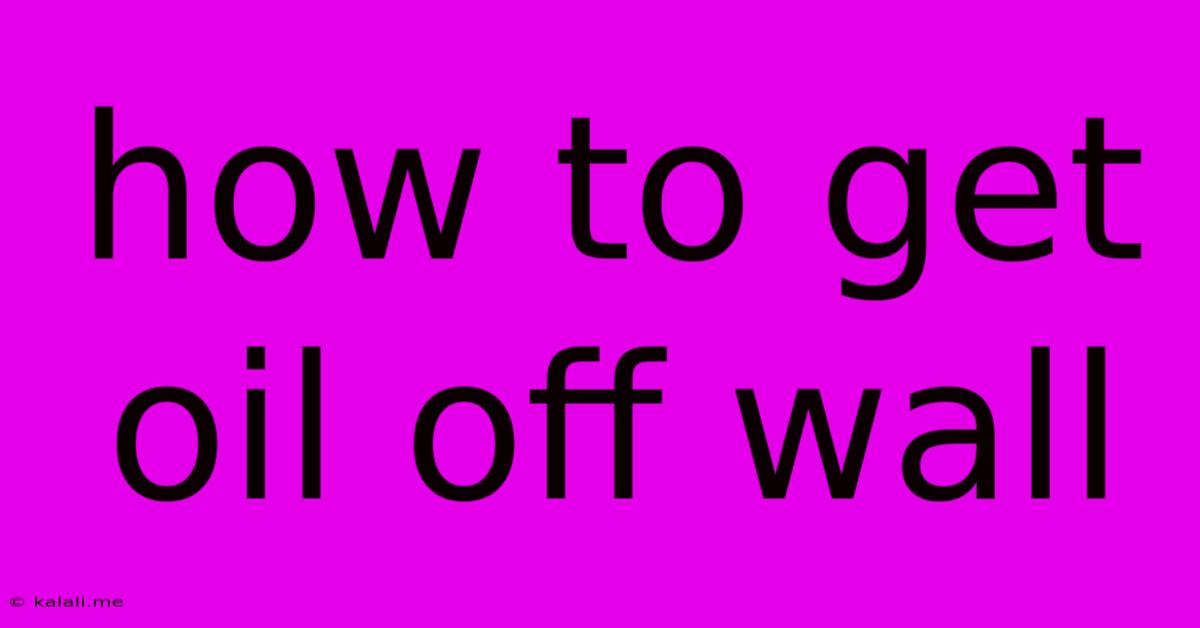How To Get Oil Off Wall
Kalali
May 20, 2025 · 3 min read

Table of Contents
How to Get Oil Off Walls: A Comprehensive Guide
Getting oil on your walls is a frustrating experience, whether it's from a cooking mishap, a leaky car, or a clumsy hand with a greasy tool. Fortunately, many effective methods exist to remove oil stains, ranging from simple household items to more specialized cleaners. This guide will walk you through various techniques, helping you choose the best approach depending on the type of oil and your wall's surface. We'll cover everything from prevention tips to tackling stubborn stains, ensuring your walls are looking pristine once more.
Understanding the Enemy: Different Oils and Wall Types
Before diving into cleaning solutions, it's crucial to understand the type of oil and the material of your wall. Different oils (vegetable oil, motor oil, etc.) have varying levels of viscosity and will require different approaches. Similarly, porous walls (like drywall) absorb oil differently than non-porous surfaces (like painted walls or tiles).
- Oil Types: Vegetable oils, cooking oils, and other lighter oils are generally easier to remove than thicker, heavier oils like motor oil or grease.
- Wall Types: The absorbency of your wall will dictate how quickly you need to act and the cleaning method you should use. Porous materials will require a more absorbent approach.
Methods for Removing Oil Stains from Walls
The key to successful oil stain removal is acting quickly. The longer the oil sits, the more it penetrates the surface and the harder it becomes to remove. Here's a breakdown of effective methods:
1. Baking Soda and Dish Soap: This is a great starting point for most oil stains. It's gentle yet effective.
- Process: Make a paste of baking soda and a little dish soap. Apply it to the stain, let it sit for 15-30 minutes, and then gently scrub with a soft sponge or cloth. Rinse thoroughly with water.
2. Dish Soap and Water: For less stubborn stains, a simple solution of dish soap and warm water might suffice.
- Process: Mix a small amount of dish soap in warm water. Apply to the stain with a sponge, gently scrub, and rinse thoroughly.
3. Commercial Degreasers: For tougher stains or heavier oils, consider using a commercial degreaser. Always test a small, inconspicuous area first to check for any discoloration or damage.
- Process: Follow the instructions on the product label carefully. Usually, you'll apply the degreaser, let it sit for a specified time, scrub gently, and then rinse thoroughly.
4. White Vinegar: Vinegar's acidity can help break down some oils. This is particularly useful for less porous surfaces.
- Process: Dilute white vinegar with water (equal parts), apply to the stain, let it sit for a few minutes, scrub gently, and rinse.
5. Isopropyl Alcohol (Rubbing Alcohol): For greasy stains on non-porous surfaces, isopropyl alcohol can be a powerful solvent. Always test in a hidden area first.
- Process: Apply a small amount of rubbing alcohol to a clean cloth, gently dab the stain (don't rub!), and blot with a clean, dry cloth to absorb the oil. Repeat as necessary.
6. Magic Eraser: While effective for some stains, magic erasers can be abrasive. Use with caution, testing on an inconspicuous area first, particularly on painted walls.
Prevention is Key: Tips to Avoid Oil Stains
While accidents happen, preventative measures can significantly reduce the likelihood of oil stains:
- Careful Cooking: Use splatter guards when cooking and clean up spills immediately.
- Proper Maintenance: Regularly maintain and inspect vehicles to prevent leaks.
- Protective Measures: Use drop cloths or protective coverings when working with oily materials.
Choosing the Right Method for Your Situation
The best method depends on the type of oil, the wall material, and the age of the stain. Start with the gentler methods (baking soda, dish soap) and progress to stronger solutions only if necessary. Remember to always test any cleaning solution on a hidden area first. Patience and persistence are key – you may need to repeat the cleaning process several times to completely remove stubborn stains. If you're unsure about a particular cleaning method or your wall's material, it's always best to consult a professional cleaning service.
Latest Posts
Latest Posts
-
How Long Can A Keg Last
May 20, 2025
-
Remove Shower Drain Cover No Screws
May 20, 2025
-
How To Remove Hair Dye From Wood
May 20, 2025
-
Water Waves Are Transverse Or Longitudinal
May 20, 2025
-
On Apple Music What Does The E Mean
May 20, 2025
Related Post
Thank you for visiting our website which covers about How To Get Oil Off Wall . We hope the information provided has been useful to you. Feel free to contact us if you have any questions or need further assistance. See you next time and don't miss to bookmark.